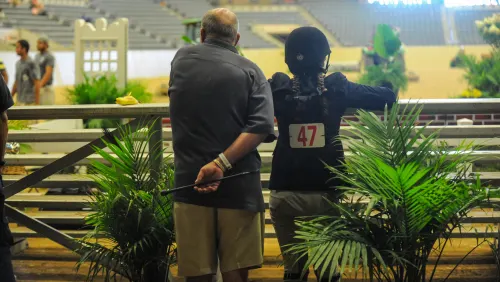The spring three-day season has drawn to a close, and horses are relaxing from their efforts at events like Rolex Kentucky, Foxhall (Ga.), Jersey Fresh (N.J.) and Virginia.
And their riders are assessing these past few months and planning the future. For some, contesting a new level is an accomplishment; for others a certain placing will decide whether they’re happy with the effort or feel as if they need to do more homework. Either way, it’s a time for reflection and planning.
As a trainer and course designer, this spring season has caused me to wonder whether we’re going too far down a wrong road. I’m talking about the distances on the cross-country courses, which are so important in determining the level and the results of any eventing competition.
These past few years have brought about a number of changes to our sport, but I’m not going to go debate the merits of one format versus the other in this column. Instead, I’m going to talk about the fact that no matter what level we’re competing, from a novice horse trial to a four-star three-day, the courses are getting shorter and shorter.
Course designers all over the world are trying to keep the competition exciting while trying to make sure that that the best riders and horses win on the day. Course design has gone through many adaptations because of the riders’ increased ability and professionalism, especially in these past 15 years.
For example, before 1980 we hardly ever saw corner jumps on a course. Now we’re introducing them at the training level and they’re standard on almost every preliminary course. And narrow fences have become so routine and mundane that now designers are being encouraged to place them on an angle away from the natural riding track in order to test the riders’ technique even more.
All of these adaptations have been to respond to the improved technique of the riders. But every time a designer invents a new challenge, the riders get better. So course designers have to constantly figure out a new way to separate the “wheat from the chaff.”
ADVERTISEMENT
The newest line of thinking is to make the courses shorter, while building the maximum number of efforts, to make the time harder to achieve and increase the influence of time faults.
At the international level, only about a quarter of the fences are truly jumped at full cross-country speed. The rest require riders to adjust their speed, to some degree, to make the fence work. The more times you have to do this, the harder it is to finish under the optimum time.
For example, at the 2000 Sydney Olympic Games, the course was more than 13 minutes long, but there were just a few times where there were more than two fences within a minute of galloping.
But things have changed fairly drastically in just five years. We course designers are now being encouraged to create courses at the minimum distance allowed–11 minutes for a four-star and seven minutes for a one-star. Even all of the horse trial courses are being shortened.
On a shorter course, it’s obviously going to be much harder to make the time because you don’t have as much galloping room to make up for the time lost while jumping. I don’t think this is having a big effect at the four-star level because 11 minutes is still a long time, but at the lower levels the shorter distances are creating a horse race.
Last year, as we adjusted to the short or Olympic format, riders noticed a wall that the horses seemed to hit at the eight-minute mark. But I think there were two major factors involved–last year–in addition to the format change.
First, most of the three-day events were held on wet ground. Three-days have always been held on wet or soft ground, but we noticed the increased effect this time because of the number of efforts in the shorter distance. The formula of maximum efforts over a minimum distance forces riders to keep their foot on the gas all the way around the course, if they want to be competitive.
ADVERTISEMENT
Second, I don’t think horses can sustain that kind of effort for that length of time. Sure, some steeplechase races run for that long or longer. But our cross-country fences require a much more intense effort, which has a cumulative effect. (Remember, horses hold their breath in the air.)
When I was starting my career, the idea that horses would need a short time on the course to catch their breath was an important consideration when walking a three-day course. Bruce Davidson and Jack Le Goff used to talk about this all the time when I walked courses with them. But you can’t do that any more.
Some will argue that having no place for a breather is removing the horsemanship factor from the game, but I don’t agree. Riders simply want to be competitive.
That means that we course designers have to be careful. We have to be sure that we’re not asking our horses to do too much. We must make sure that, in our effort to furnish exciting competition, the horses aren’t left out of the equation.
We’re limited in what we can ask by the natural physical ability of the equine species. Let’s not destroy the horse’s tremendous generosity of spirit by creating a race over extremely technical courses.
I really believe that we have to be careful following this road we’re on now. We, as riders and course designers, shouldn’t be afraid of letting the horses have a time and a place on a course where they can get into a rhythm and relax. There are many ways to make sure that the cream rises to the top.
The job of the competitive riders is to beat the game. Let’s make sure that the horses can beat the game too.














